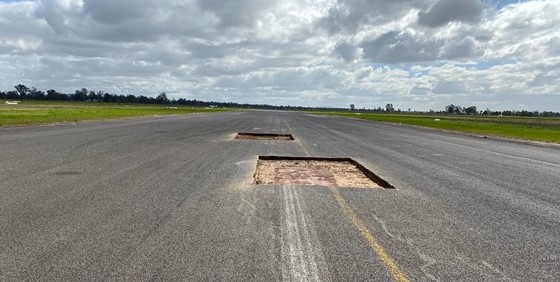
|
Key points
|
A twin-turboprop aircraft sustained substantial damage when attempting to take-off from a runway that had been closed for repair works, an Australian Transport Safety Bureau investigation details.
The Fairchild Industries SA226-T Merlin had landed at Gunnedah, northern NSW on the afternoon of 19 August 2020, and was parked there overnight.
The following morning, in line with a NOTAM published the previous day closing the runway from 0700 to enable runway repair works, a work crew had excavated two holes from the runway pavement (measuring 3 m wide by 5 m long and about 30 cm deep).
That afternoon, at about 1230 while the work crew was off-site from the airport during their lunchbreak, the Fairchild pilot commenced a take-off run on the runway for a flight to the Gold Coast.
As the aircraft accelerated, the pilot saw the two rectangular holes excavated from the runway pavement. The pilot attempted to avoid the holes, but they were struck by the aircraft’s left main landing gear.
“The aircraft sustained damage to its left main landing gear assembly, which resulted in it collapsing, and the left propellor striking the ground,” ATSB Director Transport Safety Dr Stuart Godley explained.
“The aircraft veered off the runway and came to rest outside the flight strip.”
The pilot – the sole occupant on board the aircraft – was uninjured.
“The ATSB investigation found that during pre-flight planning, the pilot had not checked for relevant NOTAMs, including one stating that Gunnedah Airport was closed due to works in progress,” Dr Godley said.
NOTAMs are accessible via the National Aeronautical Information Processing System (NAIPS) web portal and contain information concerning the establishment, condition, or change in any aeronautical facility, service, procedure, or hazard.
“An essential component of pre-flight planning is to check all NOTAMs relevant to the planned flight,” Dr Godley said.
The investigation also found that while the work crew was away on their lunch break there was no works safety officer on site. Further, while a white cross had been placed at the main windsock, visible to aircraft arriving overhead, there were no ground-visible unserviceability markings on the runway.
Both measures are required by the Civil Aviation Safety Regulations Part 139 Manual of Standards (MOS) for Aerodromes.
“Aerodrome works staff were not aware of updated MOS requirements that had come into effect seven days earlier, and had interpreted the superseded MOS to not require unserviceability markings if the whole aerodrome was closed,” Dr Godley said.
The Gunnedah Airport operator had not received notification of the updated MOS because the email included on CASA’s mailing list was for a member of staff who had left the operator. No autoreply, forwarding, or ‘hard bounce’ was in place on the email address, so CASA was not aware the email had not been received.
“To ensure receipt of correspondence that may affect safety of aircraft operations, aerodrome operators should ensure CASA is provided up to date contact details, particularly following changes to staff,” Dr Godley concluded.
Read the report: Take-off from a closed runway involving Fairchild Industries SA226, VH-LDQ, at Gunnedah Airport, New South Wales, on 20 August 2020


